Introduction The veterinary activities in the Central Rift region and Masai Mara went on successfully during the month of July, 2008
Introduction
The veterinary activities in the Central Rift region and Masai Mara went on successfully during the month of July, 2008. Some of the cases attended to include an elephant in Masai Mara and rescue of animals entangled with snares in Naivasha area. Monitoring of cases of mange infestation in cheetahs and Thompson gazelles is still a continuous exercise and more data is being collected concerning the disease. The David Sheldrick Wildlife Trust (DSWT) have pledged to buy basic laboratory equipment required in the lab to facilitate biological samples collection and processing in Mara ecosystem.
Treatment of a snared elephant in Mara Triangle area
A sub-adult male elephant was sighted in Mara triangle with a deep and severe wound on right hind limb. It was in a plain area near Mara escarpment. The elephant had difficulties in walking and could be seen limping with carrying lameness. The wound caused by the snare wire was already infected and a lot of pus was exuding from it. The Mara veterinary team responded to the case in time for treatment.
Chemical immobilization and capture
The elephant was captured by darting using 10mgs of etorphine hydrochloride combined with 1000 i.u hyaluronidase. It was darted using Dan-inject dart-gun propelled from about 10 meters. It took about 6 minutes to become recumbent. The vital physiological parameters such as respiration, body temperature and pulse rate were assessed and found normal. A lot of water was poured onto the animal to help regulate its body temperature while it was being treated, eyes were covered with an Opticlox eye ointment to prevent dessication and eye infections.
Physical examination and treatment
There was a thick wire snare still encircling the wound and this kept irritating the wound which had started the healing process. The wire was cut off using a wire cutter then the wound was further cleaned and probed using gauze swabs attached to a long forceps. Most of the soft tissues were already infected and a lot of tissue debris and pus had accumulated on the wound. The wound was cleaned with water then debrided using 10% hydrogen peroxide and later treated with a tincture of iodine solution. 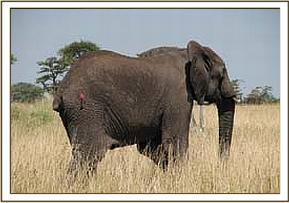
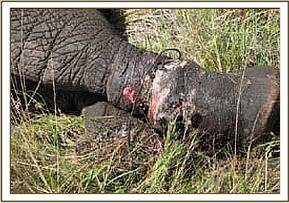
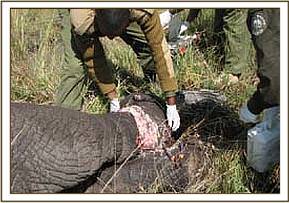

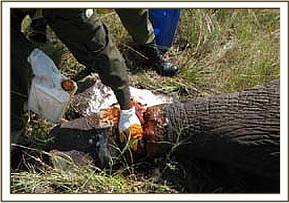

Other treatments included administration of long-acting (20%) oxytetracycline intramuscularly and multivitamins. The wound was also sprayed with oxytetracycline spray to keep off flies and enhance healing.
The animal was then revived from anaesthesia using 36mgs of Diprenorphine hydrochloride administered through the superficial ear-vein.
Some of the Thompson’s gazelles were observed and found to be suffering from a skin disease in Masai Mara national Reserve. These were found in areas of Musiara and near Mara buffalo camp. Two of them were captured by chemical immobilization through darting using 1.5mgs of etorphine hydrochloride combined with 5mgs of Xylazine hydrochloride.
They were then closely examined and mange infestation was observed on the scrotum and medial sides of the thigh, skin scrapings were collected and kept in 70% alcohol for further laboratory analysis. Each of the animals was then treated using Ivomectin administered subcutaneously. After samples collection and treatment, the animals were revived from anaesthesia using Diprenorphine hydrochloride combined with Atipamezole hydrochloride administered intravenously through the jugular vein. 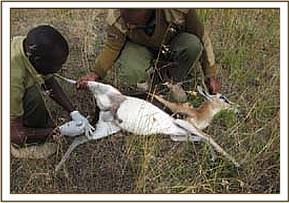

There is one female cheetah which was also sighted with mange infestation on the head and neck region, the veterinarian is still searching for it in the wild but it is not yet found because cheetahs are long ranging and rarely stay in one place for long, if found it will be treated and skin scrapping samples collected for laboratory tests. 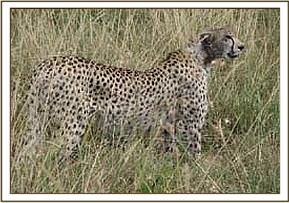
Some sheep and domestic dogs which had skin lesions were also examined and skin scrapings collected for lab analysis, this will help to verify if domestic and wild animals share same species of parasites or not so that proper control strategies can be put into place to prevent the disease from spreading from livestock to wildlife or vice versa.
Mange can be defined as a highly contagious skin disease caused by mites (Muller. et. al., 1989).Various genera of mites have been documented but the commonly found mites in cases of mange are Sarcoptes and Notoedric mites.
The disease may reach epizootic proportions in certain wildlife populations such as cheetahs in Africa (reported in Masai Mara by Mwanzia et. Al., 1995). It is believed that Cheetahs do get infected through contact with Thompson’s gazelles which is their main prey in the wild.
The net effect of a mange epizootic can have serious consequences in remnant or fragmented populations of CITES – listed, threatened or endangered species where loss of individuals through death can be critical to the survival or restoration of a species. It is therefore necessary to control mange in gazelles in order to protect cheetahs from being infected. There are continuous investigations, monitoring and treatment of mange in Masai Mara in an attempt to control the disease.
Treatment of an adult female elephant in Masai Mara
The elephant was in a large herd of about 10 elephants that are likely to have crossed from Serengeti to Mara. The case was reported by tourists who were on a game drive in the area near Roan hill. The vet team went to attend to it the following day. After several hours of searching using several tour vans and vet vehicle the elephant could not be sighted on all the possible places where it could be.
Later on we had to seek an assistance of a fixed-wing aircraft from Mr. Richard Roberts who came and hovered over the area for about 15 minutes and sighted the sick elephant in a thicket along the stream. It was then captured and treated from neck, ear and shoulder injuries caused by a wire snare attached to one of the ears.
Chemical immobilization
The elephant was captured by darting using 17mgs of etorphine hydrochloride combined with 1000 i.u hyaluronidase. It was darted using Dan-inject dart-gun propelled from about 20 meters away. It took about 6 minutes to become recumbent.
There was an electric cable wire tightly attached at the base of the left ear, it kept cutting through the ear pinnae and had caused severe and septic wounds around the ear. The wound was heavily infected and full of maggots. The wire was then cut off and removed from the wound using a pair of pliers and wire cutter.
A lot of water was used to clean the mud and maggots from wound then it properly debrided using hydrogen peroxide until all the dead tissue debris were removed. Other treatments included application of tincture of iodine and oxytetracycline spray.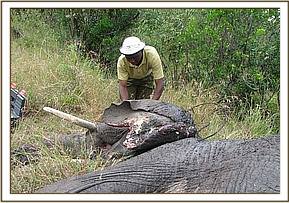
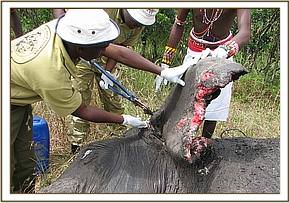
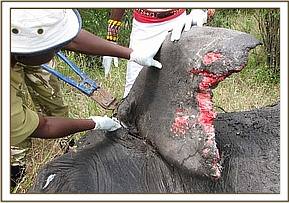
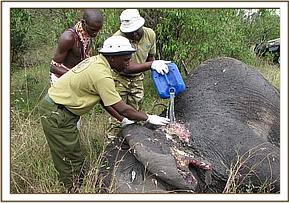
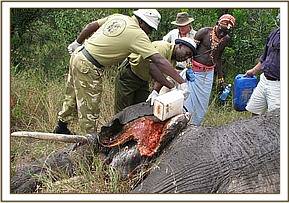

The elephant was later revived from anaesthesia using 48mgs of Diprenorphine hydrochloride and it took 3 minutes to rise up and join the rest of the herd who were nearby.
Prognosis
The animal had good chances of recovery even if the treatment was not repeated, this is because septicemia had not set in, the healing process had already begun but the hanging wire kept irritating and causing more injuries to the ear. Removal of the wire and timely treatment will save the life of the animal. Meanwhile the Mara vet team and Mara County council rangers will continue to monitor the progress of the elephant and treatment might be repeated if need be.
Removal of snares and treating a common zebra in Annex Sanctuary Naivasha
An adult female zebra had a tight wire snare round the right front limb; the wire was so tight and had caused an abrasive wound round the limb just distal to the carpal joint. The animal was reported by KWS rangers at the Annex Sanctuary and they assisted the vet team to look for it until it was found. It was immobilized by darting using 5mgs of etorphine hydrochloride combined with 60mgs of Xylazine hydrochloride and it took about 6 minutes to become recumbent. The animal was so scared and wary hence it was darted from a far distance of about 60 meters. After it was fully anaesthetized and went recumbent, the eyes were covered by a blind-fold and water poured onto it to help control the body temperature.
The wire was cut using a wire cutter and the wound treated with 10% hydrogen peroxide and tincture of iodine applied on it, an oxytetracycline spray was also applied to help keep off maggots and flies and to enhance the healing process. 
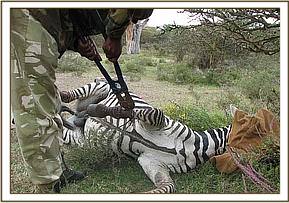

The animal was then revived from anaesthesia using 12mgs of Diprenorphine hydrochloride combined with 5mgs of Atipamezole hydrochloride, it took about 2 minutes to rise up and it took off towards the bush feeling relieved.
Euthanasia of a common zebra with a fractured limb in Naivasha.
While attending to other animals in Naivasha, the vet team was informed of an adult female zebra that had been hit by an over-speeding vehicle along the Nairobi-Naivasha highway. It was later traced and found somewhere at the middle of KWS Game Sanctuary near KWS training institute. The injury was assessed from a distant and realized that it was a complete open fracture of the metacarpal bone that caused severe pain to the animal. It had no chances of recovery and to save it from further suffering from intense pain we decided to euthanize the zebra and disposed the carcass in a deep pit within the farm. 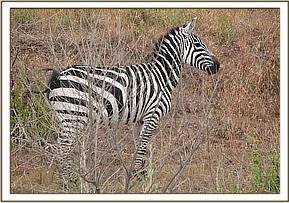

Conclusion
Once again we are grateful to inform the KWS management, David Sheldrick Wildlife Trust and other conservation partners that the veterinary activities are going on successfully in Masai Mara and other parts of Central Rift region. Basic laboratory equipment and laboratory technician are still required to help improve the veterinary services and research activities in the region. There are plans to acquire some basic laboratory equipment in the near future through support from David Shedrick Wildlife Trust (DSWT); we will also need to re-innovate and paint the laboratory rooms and vet offices in Masai Mara and acquire some furniture to make the place fully operational.
KWS Mara research station and veterinary unit do appreciates and welcome the good support from DSWT towards realization of our main objective of wildlife conservation through the provision of quality veterinary services to Kenyan wildlife.
Report by: Dr. Domnic Mijele